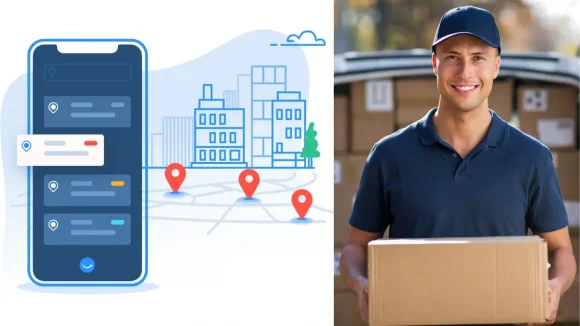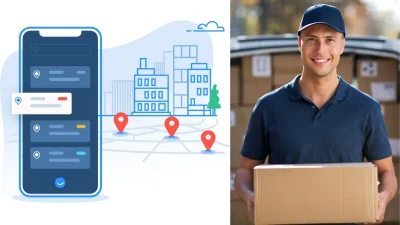Last mile delivery is the most challenging part of the overall delivery operation where failed deliveries are more likely to occur.
Failed deliveries can have a negative impact on your customers and business. One negative online review can deter several potential customers.
If you’re wanting to combat the expensive nature of this type of delivery and keep up with customer demands, then it’s important to do your research and look for solutions.
You can expect to learn about last mile delivery, the many challenges associated with it, how you can reduce costs and what last mile carrier tracking is.
What is first mile delivery?
First mile delivery is the process of shipping goods from the retailer to a courier service.
First mile delivery definitions can vary, take for instance manufacturers. Shipping could be from the manufacturing plant to a warehouse. However, for retail stores last mile delivery involves delivering goods from the store to a delivery depot.
Given it’s the first stage in the delivery journey, should a shipment experience delays it could negatively impact the entire journey like a domino effect.
If the item doesn’t make it to the customer this could result in negative reviews published online, potentially damaging the reputation of your business and customer retention.
What is middle mile delivery?
Middle mile delivery, also referred to as second mile delivery is the second stage prior to last mile delivery.
Middle mile delivery involves delivering items from a distribution centre or warehouse to fulfilment centres in which customers can purchase the products.

What is last mile logistics?
Last mile delivery, also known as final mile delivery is the final stage in the delivery process where items staying in a transportation hub are then delivered to the customer.
It’s the most time-consuming and expensive part of the shipping process, not to mention the many challenges that are encountered along the way.
Despite all of this, last mile delivery is the most important leg of the delivery journey because of the direct interaction with customers. Should delays, missing or lost items occur during the delivery, the business is unable to solve these issues prior to the customer suffering the repercussions.
What is the last mile delivery problem?
The last-mile delivery problem refers to the many inefficiencies that occur within last-mile delivery. It impacts every industry like construction and e-commerce.
Larger companies like Amazon have made same-day deliveries the go-to for customers, creating a demand that makes it difficult for other businesses to meet.
Last-mile delivery also roughly takes up more than half of total transportation costs and is extremely time-consuming.
Challenges faced in last mile delivery
Cost
Last-mile delivery is notorious for being the most expensive part of the delivery process for businesses and customers.
Due to the sudden increase in demand, businesses are finding it extremely costly to adapt and implement strategies to create cost and time-efficient deliveries.
Not having access to reliable last mile delivery software puts businesses at a disadvantage, making it all the more difficult to streamline the delivery process. Not to mention the need to assign money for additional stops, complicated routes, failed deliveries, driver costs and fleet
management.
In the event of an item being delayed due to difficulties within the delivery logistics or supply chain, the cost of deliveries will double and ultimately result in extreme financial loss.
Higher cart abandonment rates can also occur as a result of inefficiencies within the last-mile delivery, making it difficult for businesses to stay running.
Visibility
Customers today want to be part of the entire delivery process and have the ability to track their order all the way to their doorstep.
Real-time visibility is the way to build customer loyalty and lead to repeat purchases as they can access information regarding their delivery and when it will arrive.
Without real-time visibility customers can grow frustrated due to the lack of knowledge surrounding their order.
A way you can ensure customers have access to their delivery’s location is through real-time tracking offered by a reliable delivery management software (DMS). That way you can send customers a live tracking link via SMS or email so they never miss out on what’s happening during the delivery.
Delays and other delivery issues
Delivering results when it comes to allocated dates and times can be extremely difficult for businesses to achieve.
Failed deliveries and extended delays can send operational costs skyrocketing while your profits plummet. Not only that but you lose the trust of your customers when giving them less than satisfactory service.
Negative customer experience ultimately transforms into negative reviews published online for potential customers to see. This can damage your reputation and potentially harm your business.
Outdated technology
A mistake businesses often make is using outdated technology to streamline their delivery process. Modern times call for modern solutions and by continuing with traditional delivery approaches your business won’t be able to combat high shipping costs and delays.
Unfortunately, manually handling your delivery management only diminishes the efficiency of your business operations. Human error, failed or severely delayed deliveries are the types of obstacles that cannot be properly solved using outdated technology.
Using traditional methods is also not enough to meet customer expectations of today. Customers want their order delivered as soon as possible with little patience for delivery errors.
Automating your delivery process with a reliable fleet management software will increase your business’ productivity and allow you to meet customer demand. This type of technology operates so you can take back control of your business and overcome last mile challenges.
Ineffective route planning
You cannot reach the peak potential for last-mile delivery efficiency should your delivery management lack a robust foundation.
Improving last-mile deliveries start with reducing operational costs and meeting customer delivery demands. This can be achieved by planning your deliveries using a route optimisation solution.
Manually planning your routes takes hours and is a highly stressful process. There are a lot of factors that need to be considered such as driver availability, traffic and weather conditions, the type of vehicle, time allocation, the number of stops and distance between locations.
Google Maps might be a short-term solution but isn’t suitable for planning large volumes of stops. Route optimisation allows you to put your drivers on the most efficient route so they can complete deliveries faster and on time.
Lack of efficiency
Giving your customers a quality experience is a last-mile delivery challenge that can be overcome by employing an efficient delivery structure.
Dissatisfied customers, delays and failed deliveries and difficulties managing bulk orders are all ramifications of inefficiencies within last-mile deliveries.
Using a route planning software that streamlines your delivery process is what will transform your business into a productive and proactive environment where flaws and loopholes are removed from the equation.

Why is last mile delivery important?
Last mile deliveries make up over half of transportation costs, making it the most expensive part of the journey. This makes it all the more crucial for each delivery to arrive successfully otherwise it can be extremely costly for your business.
It’s also the part of the delivery process where you are delivering right to the customers’ doorstep. This makes it all the more important for the goods to arrive on time and without damage.
Last mile delivery management is important in reducing the likelihood of errors associated with shipping and to create more time-efficient deliveries for customers. This will prove beneficial to the success of your business and customer experience.
How to reduce last-mile delivery costs
Route optimisation
Dispatching and assigning deliveries to drivers can be an extremely lengthy process with multiple factors to take into account.
When there are so many other things going on in your business, you want to ensure that time is being allocated to areas that require your attention.
Route optimisation software builds the most efficient routes for your drivers in minutes so that each delivery is completed successfully and customers are satisfied.
With drivers spending less time on the road and excessively idling in severe traffic conditions, you can reduce fuel costs. Given fuel prices are continuously shifting, finding ways to reduce consumption is a great way to save money during last-mile delivery.
More delivery options
No customer is the same and neither are their delivery requirements. Offering more delivery options might initially seem like the more expensive option, however, flexible delivery options allows the customer to select what works best for them.
This increases the success rate of a customer receiving their order instead of the driver making time in their schedule to make another delivery attempt should the first timer fail.
Keeping customers updated
Today customers want to know where their delivery is at all times and receiving large time-windows from anywhere between 7am and 7pm just doesn’t cut it anymore.
By providing real-time tracking, customers are able to access the live location of the driver and receive an ETA as to when they’ll arrive.
Because the customer can see exactly where the driver is, this reduces the likelihood of a missed delivery and businesses incurring any unnecessary costs.
Proof of delivery
Not having evidence that a delivery has been completed successfully makes it easier for errors to occur and money to be lost. If a driver has delivered an item in tip top shape and the customer says it’s damaged, where’s the proof to support this?
Electronic signatures and pictures are a great way to reduce the likelihood of customer disputes and gives businesses peace of mind that each delivery has arrived safely. By enhancing your security with proof of delivery you can minimise the risk of having to reimburse customers for missing or damaged parcels.
Delivery management software
If you’re wanting to reduce last-mile delivery costs then delivery management software can help. Delivery management software can provide you with proof of delivery, route optimisation, real-time tracking and more!
Automating your entire delivery process through this software makes it easier to identify what costs are eating up most of your revenue and allows you to make changes. That way you can reduce last-mile delivery expenses and focus on improving the experience of your customers and drivers.

What is a last mile carrier?
A last mile carrier is a transportation operation that delivers goods to businesses or a customer’s preferred destination. Last mile carriers usually provide same-day delivery or next-day delivery.
They also offer tracking information so customers can know the whereabouts of their order throughout the delivery process.
Last mile carriers play an essential role in ecommerce and in ensuring that customers receive their goods at the allocated time in perfect condition.
Given last mile delivery can be a logistically difficult process, it’s integral that you partner with a carrier that has experience and success in this mode of service and delivery.
How do last mile carriers work?
The role of last mile carriers is to ensure goods arrive at the assigned destination in good condition and within the set time frame. Smaller vehicles are often used as opposed to long-haul carriers, making them more suitable for local streets when it comes to B2C and B2B deliveries.
Last mile carriers are known to operate with larger companies that transport large quantities of goods.
In order to handle the final stage of delivery, companies contract with last mile carriers from the point of goods leaving the shipper’s facility to when they are transported to customers.
The value of last mile carrier tracking for logistics managers
The last mile is the most important part of the delivery process, especially in regards to the management of supply chains and logistics.
Shipping goods from A to B is only half the job. The major challenge is making sure goods are delivered successfully and on time.
Last mile delivery tracking can be advantageous for logistics managers. Having a reliable GPS tracking system improves visibility of the whole delivery so logistics managers can see the exact location of the goods in real time. It also allows them to identify any issues during the final part of the shipping process.
Additionally, last mile tracking provides useful data that can be employed to improve shipping schedules and routes. Understanding when and where delays happen allows logistics managers to make effective changes to their operations and avoid potential errors in the future.
What are the benefits of a last mile carrier?
Working with last mile carriers allows businesses to provide customers with the best delivery experience possible. Below are some of the benefits a last mile carrier has to offer:
Improved customer satisfaction
Customer satisfaction regarding their purchase is likely to improve when goods are delivered in a quick and efficient manner.
Streamlined sales process
When a company delivers on their promise of fast and efficient deliveries, customers are more inclined to make additional purchases.
Reduced operational costs
Last mile carriers work to minimise shipping and handling costs, reducing the overall cost of goods being sold.
Valuable data
Last mile carriers can provide valuable information of customer shopping habits that a company can use to make several improvements.

What is last mile carrier tracking?
Last mile carrier tracking refers to the tracking of a package from its starting point to its final destination.
Last mile carrier tracking is typically used by businesses to see their products are delivered on time and in perfect condition. It can also be used by a consumer to track their order’s status.
Last mile carrier tracking for customers
Customers use last mile carrier tracking to guarantee their goods are being delivered at the correct location and time. It can also be employed to track the progress of the transportation process with the ability to make changes to a delivery route,
Last mile carrier tracking is the perfect solution for businesses reliant on fast deliveries such as medical suppliers or food deliveries.
It can also be used by customers to monitor personal shipments by inputting a tracking number into an online tracker. This is provided by the shipping operation.
That way customers can have complete visibility of their shipment and anticipate how long it will take. Such transparency is becoming the new norm for customers as they value timely and convenient deliveries.
Features of last mile carrier tracking
Track shipments in real time
Tracking shipments in real time is important when it comes to providing customers with accurate ETAs and having the ability to solve problems that occur during the delivery.
Integration with your e-commerce platform
An important feature of a reliable last mile carrier tracking solution is its ability to integrate seamlessly with your e-commerce platform. This works to track and manage orders.
Notifications
A good last mile carrier tracking solution will provide customers with updates of their shipment throughout the delivery process.
Reporting
Advanced reporting features are crucial for customers wanting to track delivery performance and pinpoint what needs to be improved.
Businesses that can benefit from a last mile carrier
Businesses that require products to be shipped to customers that reside in remote or rural areas can find last mile carriers to be highly valuable.
Also, businesses that sell large or bulky items can find last mile carriers to be extremely beneficial in getting products to their customers.
Last mile carriers are also helpful for businesses with time-sensitive or perishable items, as they can offer faster delivery times than other shipping methods.
How long will a last mile carrier take?
The length of time a last mile carrier can take depends on the allocated time frame and delivery routes. The average time a last mile carrier takes to ship an item takes around 1-2 days.
There are several factors that come into play when it comes to delivery times. Take for example a carrier might be able to transport an item quicker if they are travelling a shorter distance.
Also, if a carrier offers expedited shipping there will be an additional fee and can decrease the delivery from 1-2 hours (in some cases).

Optimise last mile delivery with Locate2u
If you’re wanting to reduce last mile delivery costs and optimise your overall delivery process then Locate2u can help!
Locate2u is a field and fleet management solution that allows both small and large businesses to improve their performance and customer experience. From booking management and route optimisation to real-time tracking, proof of delivery and driver ratings. You name it, Locate2u has it.
About the author
Marketing Coordinator at Locate2u having completed a Bachelor of Creative Arts, majoring in English Literature and Creative Writing. I have extensive experience in editing and proofreading, as well as creating content for a range of audiences.











